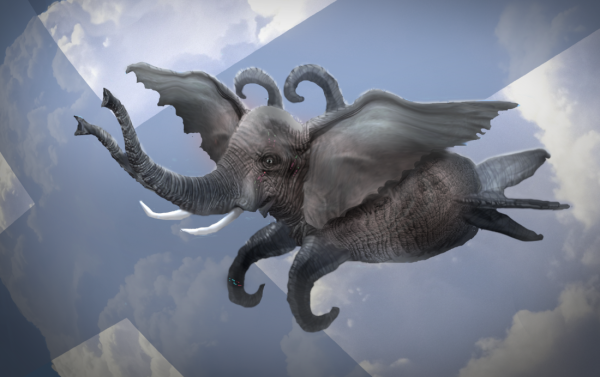BY LETTER
Aerophants
 Image from Steve Bowers | |
| An Elephant-derived species/clade gengineered for life in a free-fall environment. | |
The first aerophants were created as part of the ecosystem of the original Rolf's Donut Niven Cloud built by the MPA in 3887. The (for the time) immense microgravity ecosystem of the structure saw the birth of many new species and bodyforms, more than a few of which can still be found in use today. Aerophants were intended to graze the edges of the great freefall forests and asterisk tree groves, simultaneously preventing overgrowth and fertilizing the plants via their waste products. They were designed to also be able to readily move between different forests, groves, and water sources as needed, including through the great volumes of empty air that even the most densely biodiverse sections of the smoke ring often included.
Physical Form
The baseline aerophant bodyplan consists of a roughly ovoid body with an elephantine head that would be quite recognizable to even an ancient of Old Earth during the Information Age. The ears are significantly larger than those of a baseline Old Earth elephant and the musculature modified to provide sufficient strength and control to propel the aerophant from place to place in all three dimensions and over extended distances. The front legs have been moved forward and converted to four powerful tentacles spaced equidistantly around the body and are able to grasp or push off from tree limbs or other objects as required. The rear legs have been replaced by a smaller set of fin-like structures used for steering. The single trunk of the Old Earth elephant precursor species has been turned into a bifurcated double limb capable of reaching in and among the tangled branches of free-fall adapted plants to harvest edible leaves and fruits with ease and skill. The infrasonic signaling and detection capabilities of precursor elephants have been modified to work across the cubic kilometers of open air found in most free-fall megastructures.Variant Species
Over the centuries, hundreds of aerophant variants have been created, with virtually every element of the baseline form - including color, size, number of limbs, trunks, trunk divisions, and methods of locomotion - being changed at one time or another. From miniature versions less than a meter across originating in the freefall groves of the Aether Ring to the multi-kilometer distributed bodies of the Stormeaters of Huan Gao, the aerophant form has inspired artists and gengineers alike again and again. When one includes the various species that diverge even further from the core pachyderm ancestry, such as the aquaphants of Ys, the vacyderms of Makrania and the Great Listeners of Ecotopia, whose light-sail ears spread for tens of kilometers to propel them from place to place, the numbers become even more impressive.Many of the larger aerophant variants are home to a number of symbiotic or commensal animal species. Some of the very largest of these are functionally biohabitats, providing living space and supporting resources to entire ecosystems living on and within them - up to and including sophonts of various clades, sometimes with populations in the thousands.
Social Structures
Aerophant social structures are as varied and diverse as the species itself. While the majority of aerophant social groups - often referred to as 'flerds' (flock-herds) - operate on principles little different from their ancient ancestors on Old Earth, others are very different. Structures based on avians, cetaceans, and even insects have been incorporated into different aerophant instinct networks over the centuries. While most variants are highly social, sometimes to the point that they will sicken and die if separated from their flerd or hive for any significant period, a few have been designed to prefer solitude, only interacting with others of their kind for purposes of breeding and raising young.Provolution and Ascension
Multiple aerophant variants have been provolved, and several of these have seen ascension events among at least a few members of their clade. Most provolved aerophants choose to integrate themselves into one or another of the various sophant civilizations and enclaves scattered across Terragen space, although a few have gone on to form entire multi-system civilizations of their own. In the case of ascended aerophants, the resulting entities usually choose to take up advisory roles within their parent civilizations, although a few have launched colony missions into the Outer Volumes or Periphery while a very small number have departed for the Galactic Center, more distant parts of the Milky Way, or other galaxies in the Local Group.Related Articles
- Elephant
- Free Fall - Text by M. Alan Kazlev
A state that occurs while in orbit around a planet or other body. During free fall, the orbiting object falls toward the planet the exact same amount as the planet's surface curves beneath the object; the object seems to be continually falling toward the planet but never reaches it. The result is a condition of weightlessness. - Makrania Orwoods
- Niven Clouds (Smoke Rings)
- Sophants (Sophont Elephants)
Appears in Topics
Development Notes
Text by Todd Drashner
Initially published on 30 August 2023.
Initially published on 30 August 2023.






